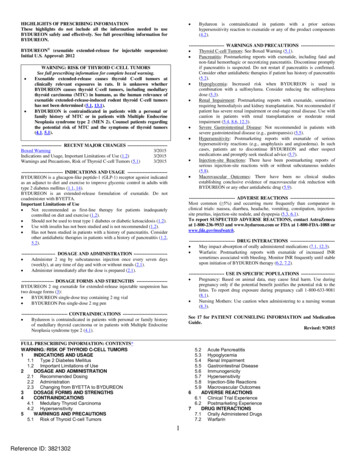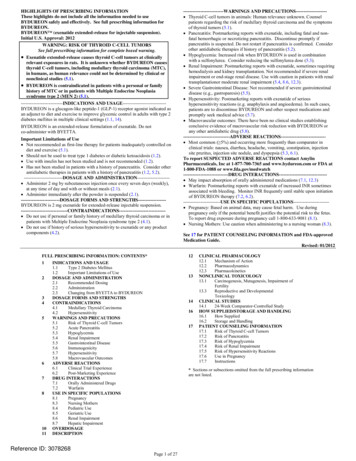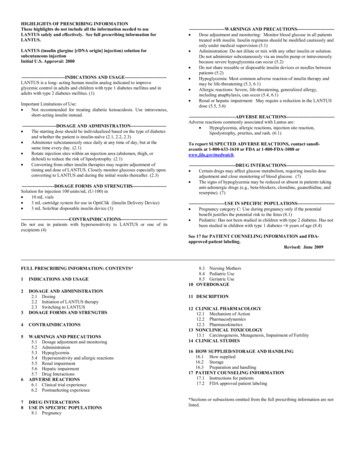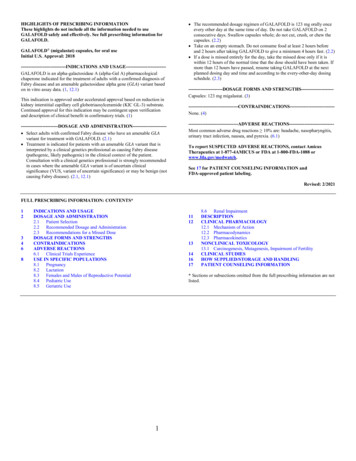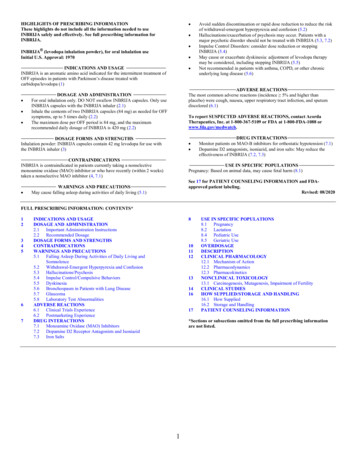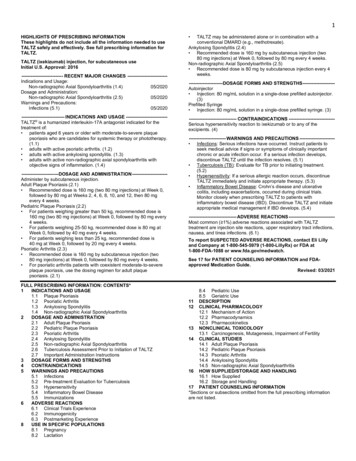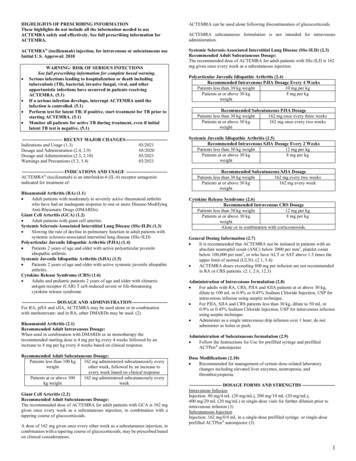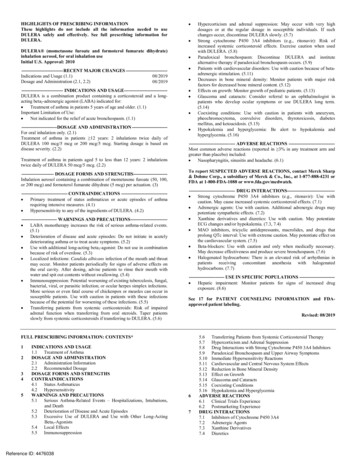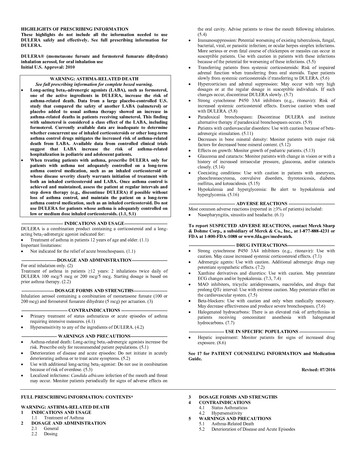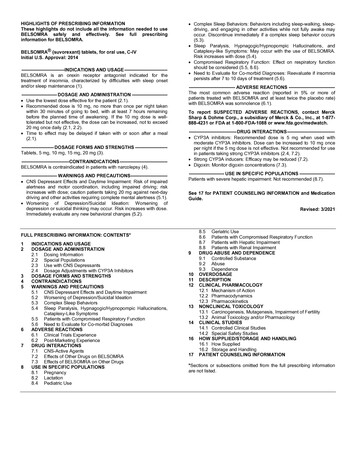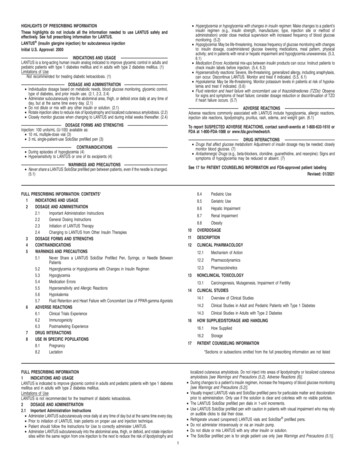
Transcription
Hyperglycemia or hypoglycemia with changes in insulin regimen: Make changes to a patient’sinsulin regimen (e.g., insulin strength, manufacturer, type, injection site or method ofadministration) under close medical supervision with increased frequency of blood glucosemonitoring. (5.2) Hypoglycemia: May be life-threatening. Increase frequency of glucose monitoring with changesto: insulin dosage, coadministered glucose lowering medications, meal pattern, physicalactivity; and in patients with renal or hepatic impairment and hypoglycemia unawareness. (5.3,6.1) Medication Errors: Accidental mix-ups between insulin products can occur. Instruct patients tocheck insulin labels before injection. (5.4, 6.3) Hypersensitivity reactions: Severe, life-threatening, generalized allergy, including anaphylaxis,can occur. Discontinue LANTUS. Monitor and treat if indicated. (5.5, 6.1) Hypokalemia: May be life-threatening. Monitor potassium levels in patients at risk of hypokalemia and treat if indicated. (5.6) Fluid retention and heart failure with concomitant use of thiazolidinediones (TZDs): Observefor signs and symptoms of heart failure; consider dosage reduction or discontinuation of TZDif heart failure occurs. (5.7)HIGHLIGHTS OF PRESCRIBING INFORMATIONThese highlights do not include all the information needed to use LANTUS safely andeffectively. See full prescribing information for LANTUS.LANTUS (insulin glargine injection) for subcutaneous injectionInitial U.S. Approval: 2000—————————————— INDICATIONS AND USAGE ——————————————LANTUS is a long-acting human insulin analog indicated to improve glycemic control in adults andpediatric patients with type 1 diabetes mellitus and in adults with type 2 diabetes mellitus. (1)Limitations of UseNot recommended for treating diabetic ketoacidosis. (1)————————————— DOSAGE AND ADMINISTRATION ————————————— Individualize dosage based on metabolic needs, blood glucose monitoring, glycemic control,type of diabetes, and prior insulin use. (2.1, 2.3, 2.4) Administer subcutaneously into the abdominal area, thigh, or deltoid once daily at any time ofday, but at the same time every day. (2.1) Do not dilute or mix with any other insulin or solution. (2.1) Rotate injection sites to reduce risk of lipodystrophy and localized cutaneous amyloidosis. (2.2) Closely monitor glucose when changing to LANTUS and during initial weeks thereafter. (2.4)——————————————— ADVERSE REACTIONS se reactions commonly associated with LANTUS include hypoglycemia, allergic reactions,injection site reactions, lipodystrophy, pruritus, rash, edema, and weight gain. (6.1)———————————— DOSAGE FORMS AND STRENGTHS ————————————Injection: 100 units/mL (U-100) available as: 10 mL multiple-dose vial (3) 3 mL single-patient-use SoloStar prefilled pen (3)To report SUSPECTED ADVERSE REACTIONS, contact sanofi-aventis at 1-800-633-1610 orFDA at 1-800-FDA-1088 or ��——— DRUG INTERACTIONS ——————————————— Drugs that affect glucose metabolism: Adjustment of insulin dosage may be needed; closelymonitor blood glucose. (7) Antiadrenergic Drugs (e.g., beta-blockers, clonidine, guanethidine, and reserpine): Signs andsymptoms of hypoglycemia may be reduced or absent. (7)————————————— WARNINGS AND PRECAUTIONS ————————————— Never share a LANTUS SoloStar prefilled pen between patients, even if the needle is changed.(5.1)See 17 for PATIENT COUNSELING INFORMATION and FDA-approved patient labelingRevised: �� CONTRAINDICATIONS During episodes of hypoglycemia (4) Hypersensitivity to LANTUS or one of its excipients (4)FULL PRESCRIBING INFORMATION: CONTENTS*1INDICATIONS AND USAGE2DOSAGE AND ADMINISTRATION2.1Important Administration Instructions2.2General Dosing Instructions2.3Initiation of LANTUS Therapy2.4Changing to LANTUS from Other Insulin Therapies3DOSAGE FORMS AND STRENGTHS4CONTRAINDICATIONS5WARNINGS AND PRECAUTIONS5.1Never Share a LANTUS SoloStar Prefilled Pen, Syringe, or Needle BetweenPatients5.2Hyperglycemia or Hypoglycemia with Changes in Insulin Regimen5.3Hypoglycemia5.4Medication Errors5.5Hypersensitivity and Allergic Reactions5.6Hypokalemia5.7Fluid Retention and Heart Failure with Concomitant Use of PPAR-gamma Agonists6ADVERSE REACTIONS6.1Clinical Trials Experience6.2Immunogenicity6.3Postmarketing Experience7DRUG INTERACTIONS8USE IN SPECIFIC POPULATIONS8.1Pregnancy8.2Lactation108.4Pediatric Use8.5Geriatric Use8.6Hepatic Impairment8.7Renal CAL PHARMACOLOGY1312.1Mechanism of LINICAL TOXICOLOGY13.1141617Carcinogenesis, Mutagenesis, Impairment of FertilityCLINICAL STUDIES14.1Overview of Clinical Studies14.2Clinical Studies in Adult and Pediatric Patients with Type 1 Diabetes14.3Clinical Studies in Adults with Type 2 DiabetesHOW SUPPLIED/STORAGE AND HANDLING16.1How Supplied16.2StoragePATIENT COUNSELING INFORMATION*Sections or subsections omitted from the full prescribing information are not listedFULL PRESCRIBING INFORMATION1INDICATIONS AND USAGELANTUS is indicated to improve glycemic control in adults and pediatric patients with type 1 diabetesmellitus and in adults with type 2 diabetes mellitus.Limitations of UseLANTUS is not recommended for the treatment of diabetic ketoacidosis.2DOSAGE AND ADMINISTRATION2.1 Important Administration Instructions Administer LANTUS subcutaneously once daily at any time of day but at the same time every day. Prior to initiation of LANTUS, train patients on proper use and injection technique. Patient should follow the Instructions for Use to correctly administer LANTUS. Administer LANTUS subcutaneously into the abdominal area, thigh, or deltoid, and rotate injectionsites within the same region from one injection to the next to reduce the risk of lipodystrophy and 1localized cutaneous amyloidosis. Do not inject into areas of lipodystrophy or localized cutaneousamyloidosis [see Warnings and Precautions (5.2), Adverse Reactions (6)].During changes to a patient’s insulin regimen, increase the frequency of blood glucose monitoring[see Warnings and Precautions (5.2)].Visually inspect LANTUS vials and SoloStar prefilled pens for particulate matter and discolorationprior to administration. Only use if the solution is clear and colorless with no visible particles.The LANTUS SoloStar prefilled pen dials in 1-unit increments.Use LANTUS SoloStar prefilled pen with caution in patients with visual impairment who may relyon audible clicks to dial their dose.Refrigerate unused (unopened) LANTUS vials and SoloStar prefilled pens.Do not administer intravenously or via an insulin pump.Do not dilute or mix LANTUS with any other insulin or solution.The SoloStar prefilled pen is for single patient use only [see Warnings and Precautions (5.1)].
2.2 General Dosing Instructions Individualize and adjust the dosage of LANTUS based on the individual’s metabolic needs, bloodglucose monitoring results and glycemic control goal. Dosage adjustments may be needed with changes in physical activity, changes in meal patterns(i.e., macronutrient content or timing of food intake), during acute illness, or changes in renal orhepatic function. Dosage adjustments should only be made under medical supervision withappropriate glucose monitoring [see Warnings and Precautions (5.2)].2.3 Initiation of LANTUS TherapyType 1 Diabetes In patients with type 1 diabetes, LANTUS must be used concomitantly with short-acting insulin.The recommended starting dose of LANTUS in patients with type 1 diabetes should beapproximately one-third of the total daily insulin requirements. Short-acting, premeal insulin shouldbe used to satisfy the remainder of the daily insulin requirements.Type 2 Diabetes The recommended starting dose of LANTUS in patients with type 2 diabetes who are not currentlytreated with insulin is 0.2 units/kg or up to 10 units once daily. One may need to adjust the amountand timing of short- or rapid-acting insulins and dosages of any oral antidiabetic drugs.2.4 Changing to LANTUS from Other Insulin Therapies If changing patients from once-daily TOUJEO (insulin glargine) 300 units/mL to once-dailyLANTUS, the recommended initial LANTUS dose is 80% of the TOUJEO dose that is beingdiscontinued. This dose reduction will lower the likelihood of hypoglycemia [see Warnings andPrecautions (5.3)]. If changing from a treatment regimen with an intermediate or long-acting insulin to a regimen withLANTUS, a change in the dose of the basal insulin may be required and the amount and timingof the shorter-acting insulins and doses of any oral antidiabetic drugs may need to be adjusted. If changing patients from once-daily NPH insulin to once-daily LANTUS, the recommended initialLANTUS dose is the same as the dose of NPH that is being discontinued. If changing patients from twice-daily NPH insulin to once-daily LANTUS, the recommended initialLANTUS dosage is 80% of the total NPH dose that is being discontinued. This dosage reductionwill lower the likelihood of hypoglycemia [see Warnings and Precautions (5.3)].3DOSAGE FORMS AND STRENGTHSInjection: 100 units per mL (U-100) available as: 10 mL multiple-dose vial (1,000 units/10 mL) 3 mL single-patient-use SoloStar prefilled pen (300 units/3 mL)4CONTRAINDICATIONSLANTUS is contraindicated: during episodes of hypoglycemia [see Warnings and Precautions (5.3)] in patients with hypersensitivity to LANTUS or one of its excipients [see Warnings and Precautions(5.5)]5WARNINGS AND PRECAUTIONS5.1 Never Share a LANTUS SoloStar Prefilled Pen, Syringe, or Needle Between PatientsLANTUS SoloStar prefilled pens must never be shared between patients, even if the needle is changed.Patients using LANTUS vials must never re-use or share needles or syringes with another person.Sharing poses a risk for transmission of blood-borne pathogens.5.2 Hyperglycemia or Hypoglycemia with Changes in Insulin RegimenChanges in an insulin regimen (e.g., insulin strength, manufacturer, type, injection site or method ofadministration) may affect glycemic control and predispose to hypoglycemia [see Warnings andPrecautions (5.3)] or hyperglycemia. Repeated insulin injections into areas of lipodystrophy or localizedcutaneous amyloidosis have been reported to result in hyperglycemia; and a sudden change in theinjection site (to unaffected area) has been reported to result in hypoglycemia [see Adverse Reactions(6)].Make any changes to a patient’s insulin regimen under close medical supervision with increasedfrequency of blood glucose monitoring. Advise patients who have repeatedly injected into areas oflipodystrophy or localized cutaneous amyloidosis to change the injection site to unaffected areas andclosely monitor for hypoglycemia. For patients with type 2 diabetes, dosage adjustments of concomitantoral and antidiabetic products may be needed.5.3 HypoglycemiaHypoglycemia is the most common adverse reaction associated with insulin, including LANTUS. Severehypoglycemia can cause seizures, may be life-threatening or cause death. Hypoglycemia can impairconcentration ability and reaction time; this may place an individual and others at risk in situationswhere these abilities are important (e.g., driving or operating other machinery).Hypoglycemia can happen suddenly and symptoms may differ in each individual and change over timein the same individual. Symptomatic awareness of hypoglycemia may be less pronounced in patientswith longstanding diabetes, in patients with diabetic nerve disease, in patients using medications thatblock the sympathetic nervous system (e.g., beta-blockers) [see Drug Interactions (7)], or in patientswho experience recurrent hypoglycemia.Risk Factors for HypoglycemiaThe risk of hypoglycemia after an injection is related to the duration of action of the insulin and, ingeneral, is highest when the glucose lowering effect of the insulin is maximal. As with all insulinpreparations, the glucose lowering effect time course of LANTUS may vary in different individuals orat different times in the same individual and depends on many conditions, including the area of injectionas well as the injection site blood supply and temperature [see Clinical Pharmacology (12.2)]. Otherfactors which may increase the risk of hypoglycemia include changes in meal pattern (e.g.,macronutrient content or timing of meals), changes in level of physical activity, or changes tocoadministered medication [see Drug Interactions (7)]. Patients with renal or hepatic impairment maybe at higher risk of hypoglycemia [see Use in Specific Populations (8.6, 8.7)].Risk Mitigation Strategies for HypoglycemiaPatients and caregivers must be educated to recognize and manage hypoglycemia. Self-monitoring ofblood glucose plays an essential role in the prevention and management of hypoglycemia. In patientsat higher risk for hypoglycemia and patients who have reduced symptomatic awareness of hypoglycemia, increased frequency of blood glucose monitoring is recommended.The long-acting effect of LANTUS may delay recovery from hypoglycemia.5.4 Medication ErrorsAccidental mix-ups among insulin products, particularly between long-acting insulins and rapid-actinginsulins, have been reported. To avoid medication errors between LANTUS and other insulins, instructpatients to always check the insulin label before each injection [see Adverse Reactions (6.3)].5.5 Hypersensitivity and Allergic ReactionsSevere, life-threatening, generalized allergy, including anaphylaxis, can occur with insulin products,including LANTUS. If hypersensitivity reactions occur, discontinue LANTUS; treat per standard of careand monitor until symptoms and signs resolve [see Adverse Reactions (6.1)]. LANTUS is contraindicated in patients who have had hypersensitivity reactions to insulin glargine or one of the excipients[see Contraindications (4)].5.6 HypokalemiaAll insulin products, including LANTUS, cause a shift in potassium from the extracellular to intracellularspace, possibly leading to hypokalemia. Untreated hypokalemia may cause respiratory paralysis,ventricular arrhythmia, and death. Monitor potassium levels in patients at risk for hypokalemia, ifindicated (e.g., patients using potassium-lowering medications, patients taking medications sensitive toserum potassium concentrations).5.7 Fluid Retention and Heart Failure with Concomitant Use of PPAR-gamma AgonistsThiazolidinediones (TZDs), which are peroxisome proliferator-activated receptor (PPAR)-gammaagonists, can cause dose-related fluid retention, particularly when used in combination with insulin.Fluid retention may lead to or exacerbate heart failure. Patients treated with insulin, including LANTUS,and a PPAR-gamma agonist should be observed for signs and symptoms of heart failure. If heart failuredevelops, it should be managed according to current standards of care, and discontinuation or dosereduction of the PPAR-gamma agonist must be considered.6ADVERSE REACTIONSThe following adverse reactions are discussed elsewhere: Hypoglycemia [see Warnings and Precautions (5.3)] Hypersensitivity and allergic reactions [see Warnings and Precautions (5.5)] Hypokalemia [see Warnings and Precautions (5.6)]6.1 Clinical Trials ExperienceBecause clinical trials are conducted under widely varying conditions, adverse reaction rates observedin clinical trials of a drug cannot be directly compared to rates in the clinical trial of another drug andmay not reflect the rates observed in practice.The data in Table 1 reflect the exposure of 2327 patients with type 1 diabetes to LANTUS or NPH.The type 1 diabetes population had the following characteristics: Mean age was 38.5 years. Fifty-fourpercent were male, 96.9% were Caucasian, 1.8% were Black or African American and 2.7% wereHispanic. The mean BMI was 25.1 kg/m2.The data in Table 2 reflect the exposure of 1563 patients with type 2 diabetes to LANTUS or NPH.The type 2 diabetes population had the following characteristics: Mean age was 59.3 years. Fifty-eightpercent were male, 86.7% were Caucasian, 7.8% were Black or African American and 9% wereHispanic. The mean BMI was 29.2 kg/m2.The frequencies of adverse events during LANTUS clinical trials in patients with type 1 diabetes mellitusand type 2 diabetes mellitus are listed in the tables below.Table 1: Adverse Events in Pooled Clinical Trials up to 28 Weeks Duration in Adults withType 1 Diabetes (adverse events with frequency 5%)LANTUS, %(n 1257)NPH, %(n 1070)Upper respiratory tract infection22.423.1Infection*9.410.3Accidental injury5.76.4Headache5.54.7*Body system not specifiedTable 2: Adverse Events in Pooled Clinical Trials up to 1 Year Duration in Adults withType 2 Diabetes (adverse events with frequency 5%)LANTUS, %(n 849)NPH, %(n 714)11.413.3Infection10.411.6Retinal vascular disorder5.87.4Upper respiratory tract infection**Body system not specifiedTable 3: Adverse Events in a 5-Year Trial of Adults with Type 2 Diabetes (adverse eventswith frequency 10%)LANTUS, %(n 514)2NPH, %(n 503)Upper respiratory tract infection29.033.6Edema .214.1Arthralgia14.216.1Pain in extremity13.013.1Back pain12.812.3Cough12.17.4Urinary tract infection10.710.1
Table 3: Adverse Events in a 5-Year Trial of Adults with Type 2 Diabetes (adverse eventswith frequency 10%) (continued)LANTUS, %(n 514)NPH, %(n .3LipodystrophyAdministration of insulin subcutaneously, including LANTUS, has resulted in lipoatrophy (depression inthe skin) or lipohypertrophy (enlargement or thickening of tissue) in some patients [see Dosage andAdministration (2.2)].Insulin Initiation and Intensification of Glucose ControlIntensification or rapid improvement in glucose control has been associated with a transitory, reversibleophthalmologic refraction disorder, worsening of diabetic retinopathy, and acute painful peripheralneuropathy. However, long-term glycemic control decreases the risk of diabetic retinopathy andneuropathy.Weight GainWeight gain has occurred with some insulin therapies including LANTUS and has been attributed tothe anabolic effects of insulin and the decrease in glucosuria.Allergic ReactionsLocal allergyAs with any insulin therapy, patients taking LANTUS may experience injection site reactions, includingredness, pain, itching, urticaria, edema, and inflammation. In clinical studies in adult patients, there wasa higher incidence of treatment-emergent injection site pain in LANTUS-treated patients (2.7%)compared to NPH insulin-treated patients (0.7%). The reports of pain at the injection site did not resultin discontinuation of therapy.Systemic allergySevere, life-threatening, generalized allergy, including anaphylaxis, generalized skin reactions, angioedema, bronchospasm, hypotension, and shock may occur with any insulin, including LANTUS andmay be life threatening.6.2 ImmunogenicityAs with all therapeutic proteins, there is potential for immunogenicity. All insulin products can elicit theformation of insulin antibodies. The presence of such insulin antibodies may increase or decrease theefficacy of insulin and may require adjustment of the insulin dose. In phase 3 clinical trials of LANTUS,increases in titers of antibodies to insulin were observed in NPH insulin and LANTUS treatment groupswith similar incidences.6.3 Postmarketing ExperienceThe following adverse reactions have been identified during postapproval use of LANTUS. Becausethese reactions are reported voluntarily from a population of uncertain size, it is not always possibleto reliably estimate their frequency or establish a causal relationship to drug exposure.Medication errors have been reported in which other insulins, particularly rapid-acting insulins, havebeen accidentally administered instead of LANTUS [see Patient Counseling Information (17)]. To avoidmedication errors between LANTUS an
2.1 Important Administration Instructions 2.2 General Dosing Instructions 2.3 Initiation of LANTUS Therapy 2.4 Changing to LANTUS from Other Insulin Therapies 3 DOSAGE FORMS AND STRENGTHS 4 CONTRAINDICATIONS 5 WARNINGS AND PRECAUTIONS 5.1 Never Share a LANTUS SoloStar Prefilled Pen, Syringe, or Needle Between Patients
